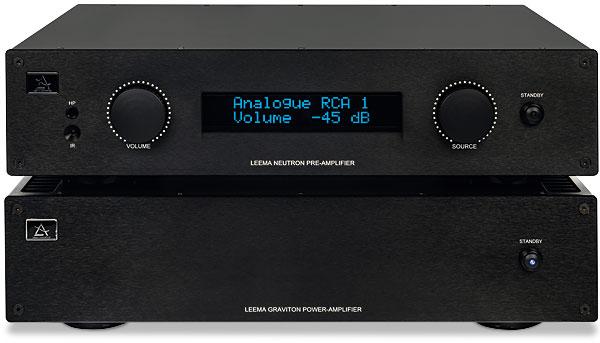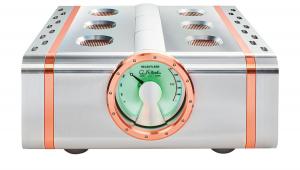Leema Acoustics Neutron/Graviton Pre/Power Amplifier

 Inspired by Leema Acoustics' flagship Constellation series, this pre/power combination is the first fruit of the Welsh brand's new Quantum range. Does the Graviton have gravitas?
Inspired by Leema Acoustics' flagship Constellation series, this pre/power combination is the first fruit of the Welsh brand's new Quantum range. Does the Graviton have gravitas?
The tone of the announcement of the new Leema Acoustics Quantum range has the air of a Hollywood blockbuster: '25 years in the making…' it begins. But perhaps this hyperbole can be forgiven as this is the Welsh company's first new range in more than ten years and sees the technology of its flagship lineup simplified to reach more affordable prices. Here we have the first two Quantum arrivals, both available in silver or black – the Neutron preamp, with 13 inputs including a built-in DAC, is £1500, as is the Graviton stereo power amp, rated at 150W/8ohm. Buy the two together and you save £200, bringing the package price down to £2800.
Both are built, as ever, in the Welshpool factory by Davlec, with which Leema merged back in 2014. The company makes its own PCBs in-house, and many of the components are shared with the Constellation series, enabling economies of scale.
A Simple Story
Given that the Hydra II power amplifier [HFN Oct '10] sells for more than three times the tag on the Graviton, what's changed to bring the prices down? Well, those in-house boards have been simplified, as has the casework used – not that you could tell from the excellent fit and finish here, complete with the machined aluminium front panels and controls. Inside, the power supplies have been reduced to single transformers in each unit, including a very large toroidal in the Graviton power amp, rather than the multiple devices found in the Constellation 'equivalents'.

The Neutron preamplifier may look simple from the front, with just two main controls for volume and source selection, a workmanlike blue on black two-line display plus a power button, IR receiver for the remote and a 6.35mm headphone socket, but it has all that input/output flexibility I hinted at before. There are four line inputs on RCA sockets and a MM/MC phono stage taken from Leema's standalone Essentials Phono, plus a set of XLR balanced analogue ins.
Meanwhile, the outputs run to a pair of XLRs and two sets of RCAs for the main preamp output, a tape output, and a stereo pair designed to feed subwoofers. In the digital department, there are three optical and three coaxial inputs, plus a USB-B port for the connection of computer sources and USB-equipped hi-fi 'music library/servers'. An ES9018 DAC, from ESS, is chosen for D/A duties though the processing is limited to 192kHz/24-bit.
Stack Machine
Input switching is via gold/palladium-plated relays, and the volume control uses a Burr-Brown IC with a switched analogue resistor ladder, as used in many past Leema products. Other niceties here include a dedicated headphone amplifier section, and a pair of 12V 'Power Link' sockets to control external equipment. And while those fascia controls look simple, there's more to them than initially meets the eye – a quick push on the volume knob mutes and unmutes the amp, while a longer five-second push and hold puts the Neutron into setup mode. The input selector will then scroll through menu options including renaming inputs, setting one input to fixed gain for use in AV set-ups, and choosing between a dB readout of volume or a 0-120 scale.

The Graviton power amp has inputs on both RCAs and XLRs, loop-through RCA outputs to enable power amps to be 'stacked' for bi-amping suitable speakers, and again those 12V control sockets. Two sets of solid, if plain and simple, output terminals are provided, allowing speakers to be bi-wired if required. Each channel is powered by six matched Toshiba output transistors, and the amp's 150W/8ohm output is claimed to rise to 260W/4ohm.
It would be easy to say the Neutron/Graviton combination doesn't have quite the equipment-rack presence of Leema's pricier Constellation models, which have a more 'styled' look about them, as befits the company's high-end contenders. However, to these eyes the newcomers have a purposeful, no-frills appearance, and not a hint of being built down to a price, from the quality of the finish to the smoothness with which the controls operate. In the 'would you give them houseroom?' stakes, they'd get a resounding thumbs-up – if the raising of a digit could be said to resound.
![]() Thrill Of It All
Thrill Of It All
Neither is there anything pared to the bone or sketchy about the sound here. Fed from sources including my reference Naim ND555/2x555PS network player [HFN Apr '19] and driving the distinctly over-achieving PMC prodigy5 floorstanding speakers, this Leema combination delivers a sound that doesn't stint on the thrills while at the same time sounding entirely in control, confident and dynamic.























































